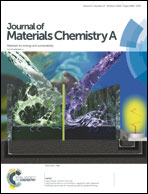From a Au-rich core/PtNi-rich shell to a Ni-rich core/PtAu-rich shell: an effective thermochemical pathway to nanoengineering catalysts for fuel cells†
Abstract
A major challenge in the design of nanocatalysts containing noble metals is the ability to engineer their relative surface composition and structure so that their catalytic activity and stability can be enhanced with minimum use of the noble metals. We demonstrate here this ability by an effective thermochemical pathway enabling us to control the structural evolution of fuel cell nanocatalysts from an Au-rich core/PtNi-rich shell to a Ni-rich core/PtAu-rich shell. The synthesis starts from the introduction of a third low-cost transition metal (nickel) into AuPt nanoparticles through a facile one-pot synthesis followed by thermochemical and electrochemical treatments. By exploiting the surface free energy differences among Au, Pt and Ni, the as-synthesized Au-rich core/PtNi-rich shell structure is transformed into a Ni-rich core/PtAu-rich shell structure, producing a significant multifunctional synergy in comparison with bimetallic PtAu nanoparticles. The surface enrichment of PtAu with slightly segregated Au, along with shrinking of Pt–Pt distances, is shown to enhance the dehydrogenation of methanol and effectively remove the surface carbonaceous species. The surface Au atoms facilitate maneuvering of the electrons in the oxidation reactions, whereas the positively charged PtAu rich surface resulted from electrochemical treatment enhances the oxidation activity. The mass activity of the nanocatalysts is shown to maximize as a function of Ni doping. The result is further supported by computational analysis of the adsorption energy of methanol on the nanoclusters, revealing that the increased catalytic activity correlates well with the decreased adsorption energy. These findings demonstrate an unprecedented ability to invert the core–shell structure of the as-synthesized nanocatalysts for electrocatalytic enhancement, which has significant implications for the design of noble metal containing nanocatalysts for fuel cells.



 Please wait while we load your content...
Please wait while we load your content...